The chartering community is closely watching the upward rally in the Black Sea area. Charterers were bidding Ultramaxes US$19,000 daily versus owners testing number of US$ 22,000 daily. Given this, one wonders where this development might lead to. Based on a steady demand, rate levels could reach US$ 30,000 daily, which then in turn would attract ballasters from North Africa and Red Sea, to name just a few areas. Inevitably other areas will benefit such as Continent from where charterers need to pay rates stopping owners from ballasting straight to the Med, which is only a couple of days away. It can be taken for granted that the next reported front haul fixture will be above US$ 20,000 daily. Grain rates to Saudi Arabia for 60,000mt are likely head towards US$ 25/mt. In sharp contrast Supra tonnage can still be fixed at US$ 6,500 daily for a trip to the US Gulf.
From ECSA Ultramax tonnage was traded around US$ 12,500-13,000 daily for a trip to the US Gulf. Supramax rates to the Continent-Med are still disappointingly weak hovering at around US$ 13,000 daily. The front haul runs have been done at rates of around US$ 14,500 daily plus US$ 450,000 BB for Ultramaxes. Tonnage of 35,000dwt has been offered US$ 10,000 daily from North Brazil to the Baltic. From the USG, the Centurion fixture at US$ 20,750 daily to WCCA, if correctly reported, looks like a promising figure and looks as if the market is in the process of changing direction for Ultra-Supramax tonnage. Handysizes are more difficult to cover with tonnage ballasting from the USEC to the US Gulf.
The market in the East has taken a painful direction for owners with nickel ore charterers getting away with rates below US$ 10,000, which is very disturbing. Ultramaxes were traded at around US$ 12,500-13,000 for 4-6 months trading with a lower rate for the first 30 days to reflect the poor spot market. Handysizes are holding steady whilst owners’ bullishness is met with calm by charterers. Despite several owners holding out for US$ 10,500-11,000 for a NoPac RV there is always the possibility to find tonnage of 33-36,000 dwt below US$ 10,000 as happened. CIS charterers were seeing 37,000 dwt at US$ 9,500 daily from North China via CIS to P.I.
Would you like to read our shipbroker viewpoint every morning?
Subscribe to the BMTI DAILY REPORT today.

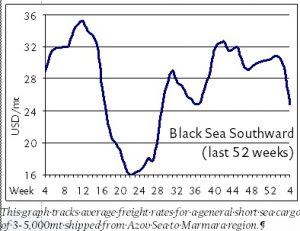 Freights continue to fall rather precipitously in the Azov trades with owners continuously coming up short on the cargo side of the market. Owners say rates have fallen so quickly since their recent peak at the end of 2018 that they are down as much as US$ 9/mt now from that point, roughly a third, considering that Azov/Marmara rates are currently in the low US$ 20s/mt on grain of 5,000mt (46′). A veritable perfect storm of bearish conditions—extended port delays at Russian ports, the stronger rouble, increased domestic commodity demand (along with lower international demand), rising domestic prices and the fairly mild winter—are conspiring to make this winter a tougher than usual one for shipowners. Kherson/TBS has stabilized at US$ 20-22/mt.
Freights continue to fall rather precipitously in the Azov trades with owners continuously coming up short on the cargo side of the market. Owners say rates have fallen so quickly since their recent peak at the end of 2018 that they are down as much as US$ 9/mt now from that point, roughly a third, considering that Azov/Marmara rates are currently in the low US$ 20s/mt on grain of 5,000mt (46′). A veritable perfect storm of bearish conditions—extended port delays at Russian ports, the stronger rouble, increased domestic commodity demand (along with lower international demand), rising domestic prices and the fairly mild winter—are conspiring to make this winter a tougher than usual one for shipowners. Kherson/TBS has stabilized at US$ 20-22/mt.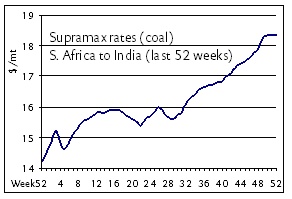 Some of the shine is already off of the
Some of the shine is already off of the 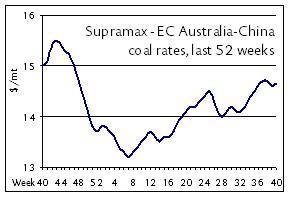
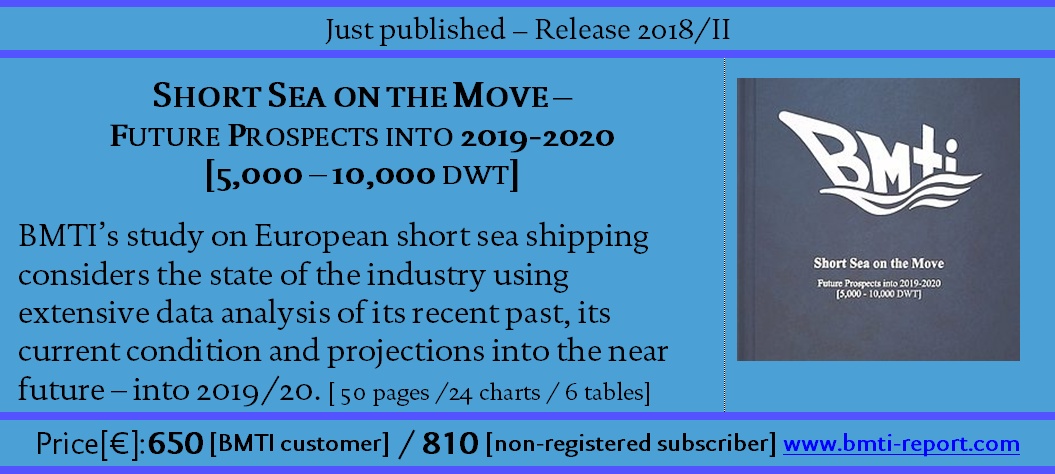
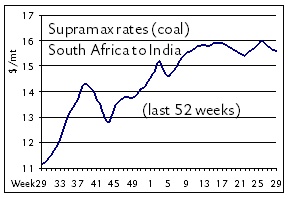
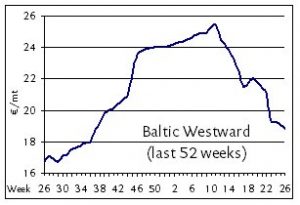 [27 JUNE 2018] With both European holidays and sluggish summer industrial trends setting in, pressure continues to grow on rates in the northern short sea markets even as owners manage to keep discounts limited. Operating costs, as always the basement level for rates to fall, have themselves taken a hit in recent weeks with bunker prices having progressively fallen, giving owners one fewer negotiating tool in keeping rates steady, if not higher. Freights in the high teens of EUR 17-18/mt on the Baltic westward routes from Balticum to ARAG (based on 3,000mt general cargo parcels) have moved slowly but surely into the mid teens of EUR 15-16/mt on the same run, brokers report. ECUK cargoes of 5,000mt are still securing around EUR 10-12/mt, depending on terms, to ARAG. Southbound spot freights remain relatively more attractive as southern European trade regions continue to attract higher activity and firmer rates than their northern counterparts. Agri-prods with stowage of 44-48′ are seen fetching EUR 24-26/mt, traders report, on business from the Upper Baltic to the French Mediterranean, more or less unchanged from rates on the same run since late May. Similar rates are reported as concluded on WCUK/Marmara business. Northbound rates from the Spanish Med to ARAG are fetching high teens of EUR 16-18/mt on mid-size parcels of 5,000mt while the same to the Upper Baltic is getting as high as EUR 22/mt. Upper Baltic to Ireland is still in the lower EUR 20s/mt, we are told, with owners keeping charterers at bay with EUR 21/mt as the lowest offer accepted.
[27 JUNE 2018] With both European holidays and sluggish summer industrial trends setting in, pressure continues to grow on rates in the northern short sea markets even as owners manage to keep discounts limited. Operating costs, as always the basement level for rates to fall, have themselves taken a hit in recent weeks with bunker prices having progressively fallen, giving owners one fewer negotiating tool in keeping rates steady, if not higher. Freights in the high teens of EUR 17-18/mt on the Baltic westward routes from Balticum to ARAG (based on 3,000mt general cargo parcels) have moved slowly but surely into the mid teens of EUR 15-16/mt on the same run, brokers report. ECUK cargoes of 5,000mt are still securing around EUR 10-12/mt, depending on terms, to ARAG. Southbound spot freights remain relatively more attractive as southern European trade regions continue to attract higher activity and firmer rates than their northern counterparts. Agri-prods with stowage of 44-48′ are seen fetching EUR 24-26/mt, traders report, on business from the Upper Baltic to the French Mediterranean, more or less unchanged from rates on the same run since late May. Similar rates are reported as concluded on WCUK/Marmara business. Northbound rates from the Spanish Med to ARAG are fetching high teens of EUR 16-18/mt on mid-size parcels of 5,000mt while the same to the Upper Baltic is getting as high as EUR 22/mt. Upper Baltic to Ireland is still in the lower EUR 20s/mt, we are told, with owners keeping charterers at bay with EUR 21/mt as the lowest offer accepted.